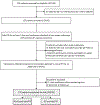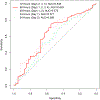Optimal Wireless Reflux Monitoring Metrics to Predict Discontinuation of Proton Pump Inhibitor Therapy
- PMID: 35973148
- PMCID: PMC9532366
- DOI: 10.14309/ajg.0000000000001871
Optimal Wireless Reflux Monitoring Metrics to Predict Discontinuation of Proton Pump Inhibitor Therapy
Abstract
Introduction: Ambulatory reflux monitoring performed off proton pump inhibitor (PPI) is the gold standard diagnostic test for nonerosive gastroesophageal reflux disease (GERD). However, the diagnostic metrics and optimal duration of monitoring are not well defined. This study evaluated the performance of multiple metrics across distinct durations of wireless reflux monitoring off PPI against the ability to discontinue PPI therapy in patients with suboptimal PPI response.
Methods: This single-arm clinical trial performed over 4 years at 2 centers enrolled adults with troublesome GERD symptoms and inadequate response to > 8 weeks of PPI. Participants underwent 96-hour wireless pH monitoring off PPI. Primary outcome was whether the subject successfully discontinued PPI or resumed PPI within 3 weeks.
Results: Of 132 participants, 30% discontinued PPI. Among multiple metrics assessed, total acid exposure time (AET) of 4.0% performed best in predicting PPI discontinuation (odds ratio 2.9 [95% confidence interval 1.4, 6.4]; P = 0.006), with other thresholds of AET and DeMeester score performing comparably. AET was significantly higher on day 1 of monitoring compared with other days, and prognostic performance significantly declined when only assessing the first 48 hours of monitoring (area under the curve for 96 hours 0.63 vs area under the curve for 48 hours 0.57; P = 0.01).
Discussion: This clinical trial highlights the AET threshold of 4.0% as a high-performing prognostic marker of PPI discontinuation. 96 hours of monitoring performed better than 48 hours, in predicting ability to discontinue PPI. These data can inform current diagnostic approaches for patients with GERD symptoms who are unresponsive to PPI therapy.
Trial registration: ClinicalTrials.gov NCT03202537.
Copyright © 2022 by The American College of Gastroenterology.
Figures



Similar articles
-
Ambulatory Reflux Monitoring Guides Proton Pump Inhibitor Discontinuation in Patients With Gastroesophageal Reflux Symptoms: A Clinical Trial.Gastroenterology. 2021 Jan;160(1):174-182.e1. doi: 10.1053/j.gastro.2020.09.013. Epub 2020 Sep 16. Gastroenterology. 2021. PMID: 32949568 Free PMC article. Clinical Trial.
-
Gastroesophageal reflux disease-related symptom recurrence in patients discontinuing proton pump inhibitors for Bravo® wireless esophageal pH monitoring study.Rev Gastroenterol Mex. 2017 Oct-Dec;82(4):277-286. doi: 10.1016/j.rgmx.2016.12.007. Epub 2017 Apr 3. Rev Gastroenterol Mex. 2017. PMID: 28385467 English, Spanish.
-
Value of pH Impedance Monitoring While on Twice-Daily Proton Pump Inhibitor Therapy to Identify Need for Escalation of Reflux Management.Gastroenterology. 2021 Nov;161(5):1412-1422. doi: 10.1053/j.gastro.2021.07.004. Epub 2021 Jul 14. Gastroenterology. 2021. PMID: 34270955
-
Clinical role of ambulatory reflux monitoring in PPI non-responders: recommendation statements.Aliment Pharmacol Ther. 2022 Oct;56(8):1274-1283. doi: 10.1111/apt.17180. Epub 2022 Aug 16. Aliment Pharmacol Ther. 2022. PMID: 35971888 Free PMC article.
-
AGA Clinical Practice Update on the Personalized Approach to the Evaluation and Management of GERD: Expert Review.Clin Gastroenterol Hepatol. 2022 May;20(5):984-994.e1. doi: 10.1016/j.cgh.2022.01.025. Epub 2022 Feb 2. Clin Gastroenterol Hepatol. 2022. PMID: 35123084 Free PMC article. Review.
Cited by
-
The San Diego Consensus for Laryngopharyngeal Symptoms and Laryngopharyngeal Reflux Disease.Am J Gastroenterol. 2025 Apr 8:10.14309/ajg.0000000000003482. doi: 10.14309/ajg.0000000000003482. Online ahead of print. Am J Gastroenterol. 2025. PMID: 40197644
-
pH Impedance Monitoring on Proton Pump Inhibitor Therapy Impacts Management Decisions in Proven GERD but not in Unproven GERD.Clin Gastroenterol Hepatol. 2025 May 16:S1542-3565(25)00417-3. doi: 10.1016/j.cgh.2025.02.032. Online ahead of print. Clin Gastroenterol Hepatol. 2025. PMID: 40383216 Free PMC article.
-
Review article: Diagnosis and management of laryngopharyngeal reflux.Aliment Pharmacol Ther. 2024 Mar;59(5):616-631. doi: 10.1111/apt.17858. Epub 2024 Jan 8. Aliment Pharmacol Ther. 2024. PMID: 38192086 Free PMC article. Review.
-
Esophageal Disorders in the Older Adult.Curr Treat Options Gastroenterol. 2025 Dec;23(1):3. doi: 10.1007/s11938-025-00468-6. Epub 2025 Feb 27. Curr Treat Options Gastroenterol. 2025. PMID: 40061442
-
Reflux Testing: Wireless pH, Impedance-pH, and Mucosal Impedance.Gastrointest Endosc Clin N Am. 2025 Jul;35(3):587-601. doi: 10.1016/j.giec.2024.12.007. Epub 2025 Jan 23. Gastrointest Endosc Clin N Am. 2025. PMID: 40412992 Review.
References
-
- Zerbib F, Bredenoord AJ, Fass R, et al. ESNM/ANMS consensus paper: Diagnosis and management of refractory gastro-esophageal reflux disease. Neurogastroenterol Motil 2020:e14075. - PubMed
-
- Capovilla G, Salvador R, Spadotto L, et al. Long-term wireless pH monitoring of the distal esophagus: prolonging the test beyond 48 hours is unnecessary and may be misleading. Dis Esophagus 2017;30:1–8. - PubMed
-
- Roman S, Mion F, Zerbib F, et al. Wireless pH capsule--yield in clinical practice. Endoscopy 2012;44:270–6. - PubMed
Publication types
MeSH terms
Substances
Associated data
Grants and funding
LinkOut - more resources
Full Text Sources
Other Literature Sources
Medical

